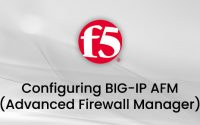Overview
This course provides network professionals with a functional understanding of the BIG-IP VIPRION platform. It includes an overview of the chassis, hardware options, Clustered Multiprocessing (CMP) and virtual CMP (vCMP) deployment options. The course includes lectures, demonstrations, hands-on labs, and discussions.
Duration 1 day.
You can find current trainings on training calendar page.
Training Prerequisites
Students must complete one of the following F5 prerequisites before attending this course:
- Administering BIG-IP instructor-led course
- F5 Certified BIG-IP Administrator
The following free web-based courses, although optional, will be very helpful for any student with limited BIG-IP administration and configuration experience.
- Getting Started with BIG-IP web-based training
- Getting Started with BIG-IP Local Traffic Manager (LTM) web-based training
- Getting Started with VIPRION web-based training
The following general network technology knowledge and experience are recommended before attending any F5 Global Training Services instructor-led course:
- OSI model encapsulation
- Routing and switching
- Ethernet and ARP
- TCP/IP concepts
- IP addressing and subnetting
- NAT and private IP addressing
- Default gateway
- Network firewalls
- LAN vs. WAN
Training Contents
The content of this training is as follows. We recommend that you review before training.
- Introducing the VIPRION System
- VIPRION 2000 Series Chassis
- VIPRION 4000 Series Chassis
- Primary and Secondary Blades
- VIPRION Cables and Transceivers
- Other Components
- Initial BIG-IP Setup Utility Steps
- Archiving the BIG-IP Configuration
- BIG-IP vCMP-Enabled Appliance Setup Labs
n
- n
- What is CMP?
- VIPRION Features and Technologies
- What is vCMP?
- vCMP Licensing and Provisioning
- F5 Virtualization
- vCMP Host and vCMP Guests
- Physical and Logical Cores
- Virtual Disks
- Flexible Resource Allocation
- High Availability Configuration
- Introducing Device Service Clustering (DSC)
- Preparing to Deploy a DSC Configuration
- Configuring DSC Communication Settings
- Establishing Device Trust
- Establishing a Sync-Failover Device Group
- Synchronizing Configuration Data
- Exploring Traffic Group Behavior
- Non-vCMP System High Availability
- Recommended VIPRION Practices
- Full Cluster Start-Up
- Adding a New Blade
- VIPRION Troubleshooting Commands
- Troubleshooting Tools
- Contact F5 Technical Support
- End User Diagnostics (EUD)
Training Objectives
- Describe VIPRION system chassis-blade architecture
- Describe CMP traffic flow in a VIPRION system
- Describe VIPRION features and technology
- Configure vCMP host and vCMP guests
- Set up multiple vCMP guests in a High Availability configuration
- Follow recommended practices for configuring the VIPRION system
- Add a blade to the VIPRION system
- Identify and resolve basic troubleshooting problems using tools such as LED indicators, log messages, identify and resolve basic troubleshooting problems using tools such as LED indicators, log messages, and tcpdump
Who should attend?
This course is intended for system and network administrators responsible for installation, setup, configuration, and administration of the BIG-IP VIPRION system. You will benefit from first attending the Configuring BIG-IP LTM instructor-led training and having several months or more experience configuring BIG-IP LTM before attending this course.
- Overview
- Prerequisites
- Contents
- Objectives
- Audience
Overview
This course provides network professionals with a functional understanding of the BIG-IP VIPRION platform. It includes an overview of the chassis, hardware options, Clustered Multiprocessing (CMP) and virtual CMP (vCMP) deployment options. The course includes lectures, demonstrations, hands-on labs, and discussions.
Duration 1 day.
You can find current trainings on training calendar page.
Training Prerequisites
Students must complete one of the following F5 prerequisites before attending this course:
- Administering BIG-IP instructor-led course
- F5 Certified BIG-IP Administrator
The following free web-based courses, although optional, will be very helpful for any student with limited BIG-IP administration and configuration experience.
- Getting Started with BIG-IP web-based training
- Getting Started with BIG-IP Local Traffic Manager (LTM) web-based training
- Getting Started with VIPRION web-based training
The following general network technology knowledge and experience are recommended before attending any F5 Global Training Services instructor-led course:
- OSI model encapsulation
- Routing and switching
- Ethernet and ARP
- TCP/IP concepts
- IP addressing and subnetting
- NAT and private IP addressing
- Default gateway
- Network firewalls
- LAN vs. WAN
Training Contents
The content of this training is as follows. We recommend that you review before training.
- Introducing the VIPRION System
- VIPRION 2000 Series Chassis
- VIPRION 4000 Series Chassis
- Primary and Secondary Blades
- VIPRION Cables and Transceivers
- Other Components
- Initial BIG-IP Setup Utility Steps
- Archiving the BIG-IP Configuration
- BIG-IP vCMP-Enabled Appliance Setup Labs
n
- n
- What is CMP?
- VIPRION Features and Technologies
- What is vCMP?
- vCMP Licensing and Provisioning
- F5 Virtualization
- vCMP Host and vCMP Guests
- Physical and Logical Cores
- Virtual Disks
- Flexible Resource Allocation
- High Availability Configuration
- Introducing Device Service Clustering (DSC)
- Preparing to Deploy a DSC Configuration
- Configuring DSC Communication Settings
- Establishing Device Trust
- Establishing a Sync-Failover Device Group
- Synchronizing Configuration Data
- Exploring Traffic Group Behavior
- Non-vCMP System High Availability
- Recommended VIPRION Practices
- Full Cluster Start-Up
- Adding a New Blade
- VIPRION Troubleshooting Commands
- Troubleshooting Tools
- Contact F5 Technical Support
- End User Diagnostics (EUD)
Training Objectives
- Describe VIPRION system chassis-blade architecture
- Describe CMP traffic flow in a VIPRION system
- Describe VIPRION features and technology
- Configure vCMP host and vCMP guests
- Set up multiple vCMP guests in a High Availability configuration
- Follow recommended practices for configuring the VIPRION system
- Add a blade to the VIPRION system
- Identify and resolve basic troubleshooting problems using tools such as LED indicators, log messages, identify and resolve basic troubleshooting problems using tools such as LED indicators, log messages, and tcpdump
Who should attend?
This course is intended for system and network administrators responsible for installation, setup, configuration, and administration of the BIG-IP VIPRION system. You will benefit from first attending the Configuring BIG-IP LTM instructor-led training and having several months or more experience configuring BIG-IP LTM before attending this course.





